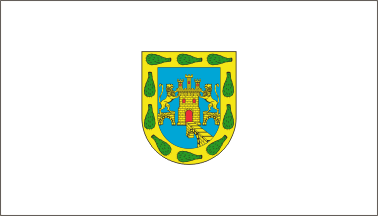
See: Coat of arms on white background: unofficial flags

Last modified: 2005-09-24 by juan manuel gabino villascán
Keywords: mexico | distrito federal | federal distric | coat of arms | lion | meshicco-tenochtitlan | lake | bridge | see | powers of the union | capital | unofficial |
Links: FOTW homepage |
search |
disclaimer and copyright |
write us |
mirrors

|
4:7 |
|
by Juan Manuel Gabino Villascán, May 06, 2001. See: Coat of arms on white background: unofficial flags |
INEGI and SEP
Reported by Juan Manuel Gabino Villascán, October 06, 2001.
The status of the Distrito Federal is defined in the articles 43 and 44 of the Mexican Constitution:
Art. 43:
The integrant parts of the Federation are the States of Aguascalientes, Baja California, Baja California Sur, (...), Zacatecas and Distrito Federal.
Art. 44:
Mexico City is the Distrito Federal, headquarters of the Powers of the Union and Capital of the United Mexican States. It is made up by the territory it currently has, and in the case the Powers of the Union move to another place, the State of the Valle de México (Valley of Mexico) will be created, with borders and area appointed by the Congress.
Juan Manuel Gabino Villascán, May 08, 2001
.gif)
Description of the arms:
"...Charles V, Emperor of Spain, issued a Royal Document signed in Valladolid on July 4, 1523, and come into effect on December 17, to replay the petition of Representatives of New Spain Francisco de Montejo and Alonso Fernández Portocarrero, who asked the Emperor granted to the City a coat of arms to be used on pennants, seals, and other places, like those used in Spain..."
Such Document says:
"...they shall have as arms a blue shield, like the water, standing for the the great lake, on which such a city was founded , and a golden castle in middle, and three bridges of stone going toward the castle, on each bridge in both sides of the castle a lion rampant (...) ten green cactus leafs with their thorns on gold border the shield (...) Such arms granted to you are able to be use on pennants, seals and flags (...)"
Originally the arms had neither mantling, crest, nor other elements in addition to those established by the Royal Document, disapointed both the Conquerors and New-Spaniards. Subsequently the arms were added a crown as crest and a mantling, but such elements were rejected by the New-Spain people who topped the arms with an eagle (usually eating a snake) standing on a cactus three.
Juan Palafox y Mendoza, Bishop of Puebla, and Viceroy of New Spain, ordered by Decree of August 12, 1642, that all represetations of the indigenous icon were removed from the City arms and "... replaced by either an image of Our Lady, an angel with a Cross, or images resemble the Catholic faith such as the Wafer and Cup...". Even the Decree the usage of the idigenous emblem extended over all the New Spain.
Juan Manuel Gabino Villascán, June 2, 2001
This flag was originated in the beginnings of the XVI
century, made in silk in pardo leonado colour, has
in the centre a great Cross of Saint Andrew, which arms
end each in a shield of Mexico City. It was placed during
the great solemnities in the central balcony of the
vice-roy palace (today National).
Jorge Candeias, 27 Oct 1997, translating from
La
Bandera Mexicana website